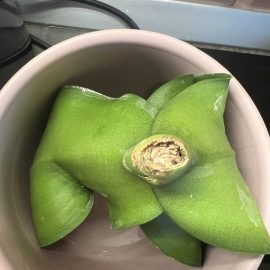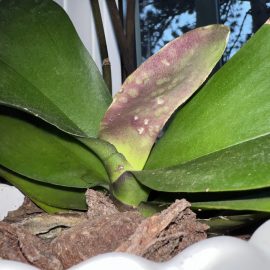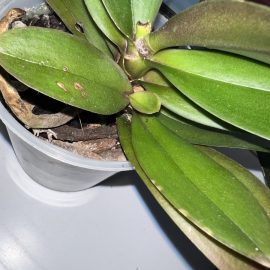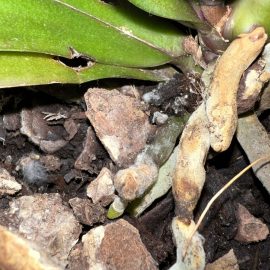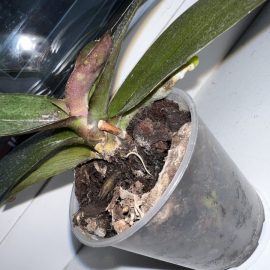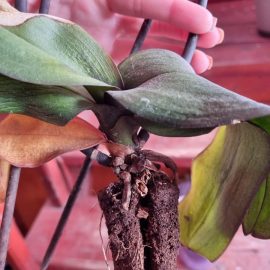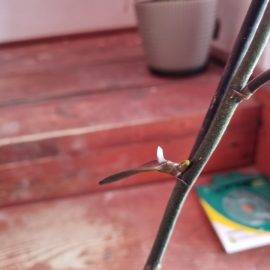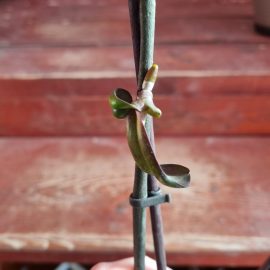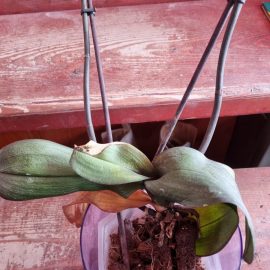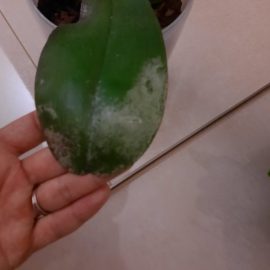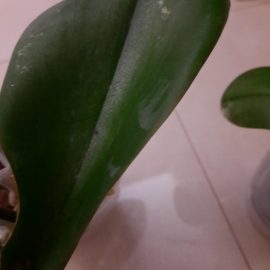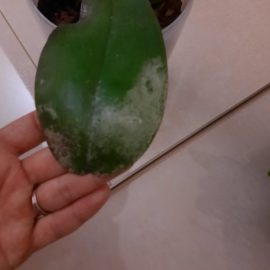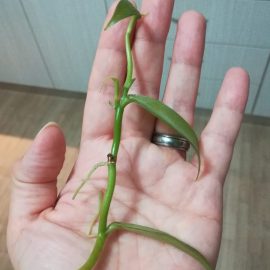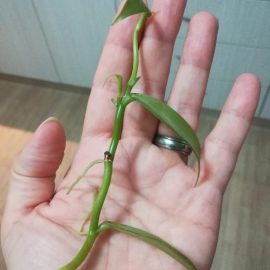Orchid, plant care and growing guide
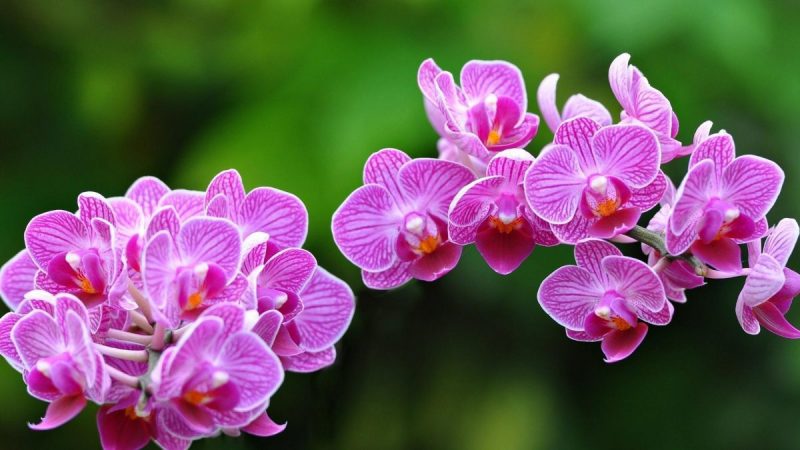
Orchid lovers say that no other plant can compete with orchids, which stand out thanks to the beauty of their flowers and the great diversity of colors, shapes and fragrances. Indeed, this large family, called the Orchidaceae family, includes approximately 800 genera, with over 30,000 species, cultivars and hybrids.
Except for the areas with extreme temperatures, orchids are found in many areas around the world, having a vast area of origin. This explains the great diversity of genera, species, varieties and hybrids.
For the most part, orchids originate from tropical and subtropical forests in areas all around the globe. Some species originate in the temperate-marine areas of North America, Europe, New Zealand and Australia.
Depending on the environment in which they grow, orchids can be divided into:
- terrestrial – they include few species, come from temperate and cold areas and fix their roots in the ground, like most plants;
- semi-terrestrial – which fix their roots on the decaying remains of other plants;
- lithophyte – which grow on rocks;
- epiphyte – includes most species of orchids. They grow, as a rule, on the trunks of trees, which they use as a support, and are not parasitic plants. They come from tropical and subtropical areas, areas with heavy rains, high humidity and positive temperatures throughout the year. These are also the species that are cultivated for commercialization, often found in the homes of orchid lovers.
Another difference between orchid species is the type of growth. Some have monopodial growth (Phalaenopsis, Vanda), that is, they have a single growth tip, short or long. Other species have sympodial growth (Cattleya, Oncidium, Cymbidium), which means that they display several growth tips.
These orchids are also differentiated by their root system. Terrestrial plants have thin, long, fibrous roots, adapted to growing in the soil, while epiphytes have thick roots, also called aerial roots. They have a layer called velamen on the surface, silver in color, with a role in absorbing water from the environment. A special role that these roots have is to carry out the photosynthesis process. The root system of orchids requires good ventilation, and excessive water is usually the reason why problems arise in these plants.
In addition to their beauty, orchids also surprise us with some curiosities, more or less known:
- The smallest orchid grows approximately 2 mm in height and is called Platystele jungermannioides;
- Grammatophyllum speciosum is known as the bigges orchid and grows naturally at the first bifurcation of the trees;
- Over time, links were created between orchid flowers and pollinators, such as the similar appearance, in order to facilitate pollination. Ophrys apifera, known as the bee orchid, attracts bees through the flower’s similar appearance;
- Vanilla is extracted from the pods of a species of orchid called Vanilla planifolia.
The biological cycle of orchids involves a period of active vegetative growth and flowering and a dormancy period, of relative or deep rest, depending on the species. Ensuring this sequence and the environmental conditions specific to each stage is vital for obtaining and maintaining healthy plants and achieving a flowering of the highest quality. The dormancy period during the year is different depending on the species, either in summer (Oncidium, Odontoglossum, Vanda) or in spring, after flowering (Coelogyne, Phalaenopsis). The lower quantities of water and the drop in temperature are the factors that determine the start of the dormancy period.
Considering that epiphytic orchids are the most commercialized and cultivated by enthusiasts, this article will refer especially to the conditions necessary for them.
The ecological requirements of epiphytic orchids
The ecological requirements vary greatly depending on the species. These demands are the result of the environmental conditions in the areas of origin, where the plants formed and evolved.
Light
This factor is the most important when it comes to the blooming of orchids. Insufficient light prevents flowering, but direct sunlight causes leaf burns. These species need strong light but do not prefer direct sunlight, therefore, the plants are placed on a windowsill facing south, east or west, so that they benefit from this resource.
In general, the appearance of the plants tells us a lot about their requirements. Regarding the influence of light on the color of the leaves, they must be light green. If the leaves benefit from too little light, they are dark green. If they receive too much light, the leaves have a yellowish-green color.
Temperature
Depending on the species, the thermal requirements fall within the range of 16–30 °C during the day and 12–24 °C at night for the warm season, respectively 13–26 °C during the day and 10–20 °C at night for the cold season. Regardless of the season, ensuring a temperature difference between day and night of 4-6 °C is vital for the smooth development of the two stages of the orchid’s biological cycle.
The question often arises: “Why doesn’t my orchid bloom anymore? It is healthy but it is not blooming.” It should be known that the temperature variation between day and night is an aspect that should not be neglected if we want to enjoy the flowers of these plants again. Floral induction takes place if a temperature difference between day and night of 4-6 °C is ensured for 4-5 weeks. Thus, during the day, temperatures slightly exceeding 20 °C can be ensured and at night the temperatures can be 15-16 °C (the ideal is the sequence of 16 °C at night / 20 °C during the day).
During the warm season, the plants can withstand temperatures of 30-35 °C for a short time, if the necessary humidity and ventilation are insured.
When the plant has buds, the temperature must not drop below 15 °C because they can wither and fall before blooming.
The relative atmospheric humidity
Being tropical plants, orchids love high atmospheric humidity. This condition is not difficult to fulfill:
- The flowerpots can be placed in trays with pebbles and water, provided that the lower part of the flowerpots does not touch the water;
- If there are several plants, they can be placed close to each other, thus maintaining a more humid microclimate;
- The plants can be sprayed with water on the leaves but without it penetrating the place where the leaf is inserted on the stem or in the middle of the rosette (central bud). The spraying is carried out, preferably, in the first part of the day, avoiding to do this towards the end of the day.
In order to grow orchids successfully, temperature, light and humidity must always be closely linked and the values of one factor must be correlated with the others. Low humidity and high temperatures are harmful to plants and can cause wilting. High humidity, correlated with low temperatures, leads to root rot.
The substrate and the flowerpot
The main functions of the substrate are to support and provide the plant with the necessary humidity for the root system, not to provide the plant with nutrients.
The substrate must be as porous and loose as possible, to ensure good water drainage, especially for epiphytic species, whose roots require a greater degree of aeration. As a rule, a mixture of 2-3 of the following materials is used: bark, coarse peat, fern roots, small pieces of cork, moss, coconut fibers, perlite.
It is recommended to use ready-made substrates, which can be found in commerce.
Recommended products
-
You can find products on a different store
Change Store -
You can find products on a different store
Change Store -
You can find products on a different store
Change Store -
You can find products on a different store
Change Store -
You can find products on a different store
Change Store -
You can find products on a different store
Change Store -
You can find products on a different store
Change Store -
You can find products on a different store
Change Store -
You can find products on a different store
Change Store -
You can find products on a different store
Change Store -
You can find products on a different store
Change Store -
You can find products on a different store
Change Store -
You can find products on a different store
Change Store -
You can find products on a different store
Change Store -
You can find products on a different store
Change Store -
You can find products on a different store
Change Store -
You can find products on a different store
Change Store -
You can find products on a different store
Change Store -
You can find products on a different store
Change Store -
You can find products on a different store
Change Store -
You can find products on a different store
Change Store -
You can find products on a different store
Change Store -
You can find products on a different store
Change Store -
You can find products on a different store
Change Store
The flowerpot of epiphytic orchids is preferably transparent, because its roots need light to carry out photosynthesis. For a good ventilation of the roots, it is necessary that the pot has enough holes at the bottom, so that there is no risk of water stagnation.
Orchid care
Watering the plants
The substrate of the orchids must not be very wet (saturated with water) but not very dry. Most orchids prefer the substrate to dry before watering again, thus eliminating the risk of excessive water accumulation.
Water quality: you can use tap water, kept for 24 hours in an open container. Rainwater, preferably from a less polluted area, is highly recommended for watering indoor plants. Regardless of the water source, it is administered to the plant when it is at room temperature, to protect the plant from thermal shocks.
When to water: The administration of water is carried out in the early hours of the day, so that the substrate can partially dry until the evening. It is preferable not to water the plants in the evening.
The plants are watered once every 10-12 days in the winter and once every 7-8 days in the summer, but, pay attention – the frequency of watering depends a lot on the environmental conditions of the plant, the size of the flowerpot and the type of substrate.
A smaller pot requires watering more often, while a larger pot keeps the humidity of the substrate longer, so it requires to be watered less often.
The bark substrate dries more easily than the peat substrate.
The temperature of the room and the drafts influence how quickly the substrate of the plant dries, and thus, the frequency of watering must always be established according to them.
In order to eliminate any uncertainty regarding the optimal watering moment, you can easily check the humidity of the substrate. This can be done with your finger, at a depth of 2-3 cm in the substrate or with the help of a pencil. If it feels moist to the touch, the plant does not need water yet. If the substrate is dry, then the plant needs to be watered.
How to water:
- Watering is done by immersing the pot in water for 10-15 minutes, until the entire substrate is damp, after which all the water is drained from the pot and the tray, so that the roots do not stay in the water. When applying this method, it is considered that the water does not penetrate into the center of the leaf rosette or at the point where the leaves are inserted onto the stem. If the water stagnates in these areas, there is a risk that the plant will rot.
- Another method consists in pouring water into the flowerpot until it flows into the tray. After the water drains, the tray is emptied.
Fertilizing
When: As a general rule, weekly or bimonthly application is recommended during the vegetative growth period (when the plant displays new growths), with smaller amounts of fertilizer (a quarter of the recommended dose needs to be used). Once the new growths mature, reduce the amount of fertilizer administered and stop completely during the dormancy period of the plant.
Also, stop fertilizing plants that have diseases or a poor state of health.
Fertilizing during the flowering period leads to a faster wilting of the flowers, so it must be stopped during this period as well.
With what: It is recommended to use fertilizers specially created for orchids, available commercially, which contain nitrogen, phosphorus, potassium and trace elements.
Towards autumn, fertilizers with higher amounts of phosphorus and potassium can be used, in order to favor the growth of the roots and flower stems.
Recommended products
-
You can find products on a different store
Change Store -
You can find products on a different store
Change Store -
You can find products on a different store
Change Store -
You can find products on a different store
Change Store -
You can find products on a different store
Change Store -
You can find products on a different store
Change Store -
You can find products on a different store
Change Store -
You can find products on a different store
Change Store -
You can find products on a different store
Change Store -
You can find products on a different store
Change Store -
You can find products on a different store
Change Store -
You can find products on a different store
Change Store -
You can find products on a different store
Change Store -
You can find products on a different store
Change Store -
You can find products on a different store
Change Store -
You can find products on a different store
Change Store -
You can find products on a different store
Change Store -
You can find products on a different store
Change Store -
You can find products on a different store
Change Store -
You can find products on a different store
Change Store -
You can find products on a different store
Change Store -
You can find products on a different store
Change Store -
You can find products on a different store
Change Store -
You can find products on a different store
Change Store
What else do we need to know:
- Fertilizers are applied in the quantities specified by the manufacturer or even smaller and never in larger amounts, so as not to burn the roots.
- Once a month, water the plant without adding fertilizers, to eliminate the excess of salts left in the substrate after fertilizing. It is important to do this in the case of orchids to protect the roots against burns.
Transplanting
This is carried out once every 18-24 months and is usually done in spring or after the flowers have wilted. Plants that have flowers or are about to bloom must not be transplanted because there is a risk that the flowers will fall.
Transplanting aims to replace the old substrate with a new one and a larger flowerpot is not always needed. If the plant has cramped roots and the need to replace the pot is observed, it should not be much larger than the old one. If it is transplanted into a pot that is too large, the plant will develop the roots to the detriment of flowering. It is recommended that the new substrate be purchased from a specialized shop, and it needs to be specially formulated for orchids.
For transplanting, remove the plant from the old pot, remove the old substrate completely and cut the dry or damaged roots. In the new pot, put a handful of the new substrate, place the plant so that the roots are dispersed throughout the pot and fill the spaces between the roots with substrate. The area between the roots and the stem must be above the substrate. If it is necessary to support the plant, a tutor is used.
Do not apply fertilizers immediately after transplanting. Place the plants in a less bright place and spray the leaves daily.
Stimulating the flowering
Orchids will form a new flower stem if they benefit from a period of dormancy after the last flowering and from the appropriate environmental conditions, listed and detailed above.
In short:
- light: orchids require intense natural light but do not prefer direct sunlight. Insufficient light is one of the reasons why sometimes they don’t bloom;
- temperature: it is important that the plant benefits from a period with 4-6 °C differences between day and night to induce the formation of the floral stem;
- humidity: not too much, not too little. Avoid placing the plants near heat sources and do not let the water stagnate at the roots level;
- fertilizing: very important for the growth and development of a healthy and vigorous plant;
- the flowerpot: preferably, transparent and it needs to allow a very good water drainage. The side holes ensure a good ventilation of the roots.
Dormancy + light + temperature variation + fertilization = Flowering
After flowering, after the last flower falls, cut the floral stem from the base. If you want to obtain a keiki, cut the stem so that 1-2 knots remain.
Propagation
Sometimes, plants, called keiki, can appear at the nodes of the flower stem, which can be detached from the mother plant and planted separately after forming some roots. To stimulate the formation of keiki, after the flowers wilt, cut the floral stem above 1-2 nodes. This is the main method of propagating epiphytic orchids available to amateur growers. On a large scale, “in vitro” multiplication is used, being carried out in specialized laboratories.
Diseases
BACTERIOSIS
Erwinia spp.
The symptoms of this bacteriosis are manifested by the appearance of spots with a wet appearance, as a rule, surrounded by yellowed areas. Bacteria easily enter the plant through wounds and spread rapidly if protective measures are not taken. Phalaenopsis plants can be completely destroyed in a few days. Some species may present a deepened tissue, like a gap, in the area of the wet spot.
Prevention and control measures: Bacteria prefer a moist and warm environment. In case of occurrence, the affected area is removed with the help of a disinfected knife, after which treatments with fungicides are applied, both to the affected plant and to the neighboring plants.
Pseudomonas spp.
The symptoms of this disease appear on the surface of the leaf in the form of wet spots, like swellings filled with a muddy green liquid. These spots expand, merge and become brown or blackish, deep in the tissue of the leaf.
In Phalaenopsis plants, the spots are surrounded by yellow areas and the disease progresses rapidly.
Prevention and control measures: In case of occurrence, reduce the humidity and temperature, clean the affected area and apply treatments with specific fungicides.
Against bacteriosis, treatments are applied with:
Recommended products
-
You can find products on a different store
Change Store -
You can find products on a different store
Change Store -
You can find products on a different store
Change Store -
You can find products on a different store
Change Store -
You can find products on a different store
Change Store -
You can find products on a different store
Change Store -
You can find products on a different store
Change Store -
You can find products on a different store
Change Store -
You can find products on a different store
Change Store -
You can find products on a different store
Change Store -
You can find products on a different store
Change Store -
You can find products on a different store
Change Store -
You can find products on a different store
Change Store -
You can find products on a different store
Change Store -
You can find products on a different store
Change Store -
You can find products on a different store
Change Store -
You can find products on a different store
Change Store -
You can find products on a different store
Change Store -
You can find products on a different store
Change Store -
You can find products on a different store
Change Store -
You can find products on a different store
Change Store -
You can find products on a different store
Change Store -
You can find products on a different store
Change Store -
You can find products on a different store
Change Store
MYCOSIS
Pythium spp, Phytophthora spp.
Symptoms can appear on all plant organs. As a rule, they appear on the underside of the leaves in the form of wet, brown spots that darken in color, which then turn purple black. Sometimes the spots are accompanied by a yellowed edge. The pathogen can attack the roots, rhizomes, pseudobulbs and new growths. In humid conditions, the disease spreads quickly.
Prevention and control measures: Conditions of high humidity and temperature favor the appearance and spread of the disease. In case of a strong attack, the plant has to be isolated from the others to prevent healthy plants from getting infested. Before applying fungicides, clean the affected area as much as possible.
Recommended products
-
You can find products on a different store
Change Store -
You can find products on a different store
Change Store -
You can find products on a different store
Change Store -
You can find products on a different store
Change Store -
You can find products on a different store
Change Store -
You can find products on a different store
Change Store -
You can find products on a different store
Change Store -
You can find products on a different store
Change Store -
You can find products on a different store
Change Store -
You can find products on a different store
Change Store -
You can find products on a different store
Change Store -
You can find products on a different store
Change Store -
You can find products on a different store
Change Store -
You can find products on a different store
Change Store -
You can find products on a different store
Change Store -
You can find products on a different store
Change Store -
You can find products on a different store
Change Store -
You can find products on a different store
Change Store -
You can find products on a different store
Change Store -
You can find products on a different store
Change Store -
You can find products on a different store
Change Store -
You can find products on a different store
Change Store -
You can find products on a different store
Change Store -
You can find products on a different store
Change Store
Fusarium spp.
This pathogen blocks the vascular tissues of the plant, causing the plant to be “thirsty”, even if it benefits from sufficient water. The plant displays yellowed, dehydrated leaves.
In case of strong infection, this pathogen leads to the death of the plants within a few months.
Prevention and control measures: Prevention of the occurrence of this pathogen is achieved through rigorous hygiene. It is recommended to use disinfected tools. In case of infection, the root system is bathed in Topsin solution.
Recommended products
-
You can find products on a different store
Change Store -
You can find products on a different store
Change Store -
You can find products on a different store
Change Store -
You can find products on a different store
Change Store -
You can find products on a different store
Change Store -
You can find products on a different store
Change Store -
You can find products on a different store
Change Store -
You can find products on a different store
Change Store -
You can find products on a different store
Change Store -
You can find products on a different store
Change Store -
You can find products on a different store
Change Store -
You can find products on a different store
Change Store -
You can find products on a different store
Change Store -
You can find products on a different store
Change Store -
You can find products on a different store
Change Store -
You can find products on a different store
Change Store -
You can find products on a different store
Change Store -
You can find products on a different store
Change Store -
You can find products on a different store
Change Store -
You can find products on a different store
Change Store -
You can find products on a different store
Change Store -
You can find products on a different store
Change Store -
You can find products on a different store
Change Store -
You can find products on a different store
Change Store
Rhizoctonia spp.
It is a disease of the roots that occurs in conditions of excessive humidity and poor drainage of the substrate. If it is not detected and treated in time, this disease leads to the death of the plant.
The roots are soft and moist and have a dark color and the leaves are soft and droopy. The plant stops blooming and shows signs of drying.
Prevention and control measures: To prevent the occurrence of the disease, avoid the excessive humidity of the substrate and the periodic transplanting of the plants is recommended. In case of infection, the affected parts of the root are removed with the help of a disinfected tool, the plant will be transplanted into a fresh substrate, after which a specific fungicide will be applied by watering.
Recommended products
-
You can find products on a different store
Change Store -
You can find products on a different store
Change Store -
You can find products on a different store
Change Store -
You can find products on a different store
Change Store -
You can find products on a different store
Change Store -
You can find products on a different store
Change Store -
You can find products on a different store
Change Store -
You can find products on a different store
Change Store -
You can find products on a different store
Change Store -
You can find products on a different store
Change Store -
You can find products on a different store
Change Store -
You can find products on a different store
Change Store -
You can find products on a different store
Change Store -
You can find products on a different store
Change Store -
You can find products on a different store
Change Store -
You can find products on a different store
Change Store -
You can find products on a different store
Change Store -
You can find products on a different store
Change Store -
You can find products on a different store
Change Store -
You can find products on a different store
Change Store -
You can find products on a different store
Change Store -
You can find products on a different store
Change Store -
You can find products on a different store
Change Store -
You can find products on a different store
Change Store
Anthracnose – Colletotrichum spp.
This disease affects the aerial parts of the plant. The symptoms on the leaves can be manifested by the browning of their tips or by the appearance of gray or brown spots along the leaves. Above the spots, the fruiting bodies of the fungus can be seen in the form of black dots.
The symptoms on the flowers are manifested in the form of wet, blackish spots, located on the lower part of the petals and sepals.
Prevention and control measures: Anthracnose occurs in conditions of high humidity and temperature and low light. In case of occurrence, in order to prevent the progression of the disease, it is recommended to reduce the temperature and humidity, ensure sufficient light and ventilation.
Treatments with specific fungicides to control anthracnose are applied.
Recommended products
-
You can find products on a different store
Change Store -
You can find products on a different store
Change Store -
You can find products on a different store
Change Store -
You can find products on a different store
Change Store -
You can find products on a different store
Change Store -
You can find products on a different store
Change Store -
You can find products on a different store
Change Store -
You can find products on a different store
Change Store -
You can find products on a different store
Change Store -
You can find products on a different store
Change Store -
You can find products on a different store
Change Store -
You can find products on a different store
Change Store -
You can find products on a different store
Change Store -
You can find products on a different store
Change Store -
You can find products on a different store
Change Store -
You can find products on a different store
Change Store -
You can find products on a different store
Change Store -
You can find products on a different store
Change Store -
You can find products on a different store
Change Store -
You can find products on a different store
Change Store -
You can find products on a different store
Change Store -
You can find products on a different store
Change Store -
You can find products on a different store
Change Store -
You can find products on a different store
Change Store
Cercospora spp.
Initially, the infection manifests itself in the form of yellow spots on the underside of the leaf that extend to the topside, followed by necrotic, deep, blackish-brown spots. The affected leaves fall prematurely.
Prevention and control measures: In the event of an infection, avoid high humidity at the leaves level and ensure good ventilation.
The affected leaves are removed and treatments with specific fungicides to control cercosporiosis are applied.
Botrytis spp.
This pathogen attacks especially the flowers and manifests itself at first in the form of small, brown spots. The spots enlarge and can cover the entire flower. In humid conditions, a gray fluff appears on top of the spots.
Prevention and control measures: The affected flowers are removed, excessive humidity is avoided and a good ventilation is ensured. Effective products that can be applied against gray rot:
Recommended products
-
You can find products on a different store
Change Store -
You can find products on a different store
Change Store -
You can find products on a different store
Change Store -
You can find products on a different store
Change Store -
You can find products on a different store
Change Store -
You can find products on a different store
Change Store -
You can find products on a different store
Change Store -
You can find products on a different store
Change Store -
You can find products on a different store
Change Store -
You can find products on a different store
Change Store -
You can find products on a different store
Change Store -
You can find products on a different store
Change Store -
You can find products on a different store
Change Store -
You can find products on a different store
Change Store -
You can find products on a different store
Change Store -
You can find products on a different store
Change Store -
You can find products on a different store
Change Store -
You can find products on a different store
Change Store -
You can find products on a different store
Change Store -
You can find products on a different store
Change Store -
You can find products on a different store
Change Store -
You can find products on a different store
Change Store -
You can find products on a different store
Change Store -
You can find products on a different store
Change Store
VIRUSES
The presence of viruses is visible on the leaves, by necrotic spots or in the form of circles and lines. The same type of symptoms also appears on the flowers.
In case of detecting the infection with a virus, it is recommended to destroy the plant in order to prevent its spread, considering that there is no treatment against this pathogen.
In order to prevent the appearance and spread of viruses, the pests that are considered vectors, such as aphids, thrips, greenhouse whitefly, must be kept under control. When transplanting, it is recommended to use new or disinfected flowerpots and unused substrate.
Recommended products
-
You can find products on a different store
Change Store -
You can find products on a different store
Change Store -
You can find products on a different store
Change Store -
You can find products on a different store
Change Store -
You can find products on a different store
Change Store -
You can find products on a different store
Change Store -
You can find products on a different store
Change Store -
You can find products on a different store
Change Store -
You can find products on a different store
Change Store -
You can find products on a different store
Change Store -
You can find products on a different store
Change Store -
You can find products on a different store
Change Store -
You can find products on a different store
Change Store -
You can find products on a different store
Change Store -
You can find products on a different store
Change Store -
You can find products on a different store
Change Store -
You can find products on a different store
Change Store -
You can find products on a different store
Change Store -
You can find products on a different store
Change Store -
You can find products on a different store
Change Store -
You can find products on a different store
Change Store -
You can find products on a different store
Change Store -
You can find products on a different store
Change Store -
You can find products on a different store
Change Store
Pests
Scale beetles – Coccus herperidum, Coccus longulus
These insects are located on the underside of the leaves, in their axils, on the rhizomes and pseudobulbs where they bite and feed on the intracellular fluid. Following the attack, chlorotic spots appear on the leaves, followed by the premature fall of the leaves.
Prevention and control measures: In case of observing a small number of pests, they can be removed with the help of a napkin. In case of severe attack, specific insecticide treatments are applied.
Recommended products
-
You can find products on a different store
Change Store -
You can find products on a different store
Change Store -
You can find products on a different store
Change Store -
You can find products on a different store
Change Store -
You can find products on a different store
Change Store -
You can find products on a different store
Change Store -
You can find products on a different store
Change Store -
You can find products on a different store
Change Store -
You can find products on a different store
Change Store -
You can find products on a different store
Change Store -
You can find products on a different store
Change Store -
You can find products on a different store
Change Store -
You can find products on a different store
Change Store -
You can find products on a different store
Change Store -
You can find products on a different store
Change Store -
You can find products on a different store
Change Store -
You can find products on a different store
Change Store -
You can find products on a different store
Change Store -
You can find products on a different store
Change Store -
You can find products on a different store
Change Store -
You can find products on a different store
Change Store -
You can find products on a different store
Change Store -
You can find products on a different store
Change Store -
You can find products on a different store
Change Store
To favor the penetration of the insecticide through the wax shield, it is recommended to add an adjuvant to the treatment solution.
Recommended products
-
You can find products on a different store
Change Store -
You can find products on a different store
Change Store -
You can find products on a different store
Change Store -
You can find products on a different store
Change Store -
You can find products on a different store
Change Store -
You can find products on a different store
Change Store -
You can find products on a different store
Change Store -
You can find products on a different store
Change Store -
You can find products on a different store
Change Store -
You can find products on a different store
Change Store -
You can find products on a different store
Change Store -
You can find products on a different store
Change Store -
You can find products on a different store
Change Store -
You can find products on a different store
Change Store -
You can find products on a different store
Change Store -
You can find products on a different store
Change Store -
You can find products on a different store
Change Store -
You can find products on a different store
Change Store -
You can find products on a different store
Change Store -
You can find products on a different store
Change Store -
You can find products on a different store
Change Store -
You can find products on a different store
Change Store -
You can find products on a different store
Change Store -
You can find products on a different store
Change Store
Woolly aphids – Pseudococcus, Planococcus
They attack all parts of the plant, but can be found especially on the stem and in the area where the leaves are inserted on the stem. Following the attack, the leaves display yellowed areas, which darken in color and cause the premature fall. These pests can be seen with the naked eye.
Prevention and control measures: For prevention and control, treatments with specific insecticides are applied.
Recommended products
-
You can find products on a different store
Change Store -
You can find products on a different store
Change Store -
You can find products on a different store
Change Store -
You can find products on a different store
Change Store -
You can find products on a different store
Change Store -
You can find products on a different store
Change Store -
You can find products on a different store
Change Store -
You can find products on a different store
Change Store -
You can find products on a different store
Change Store -
You can find products on a different store
Change Store -
You can find products on a different store
Change Store -
You can find products on a different store
Change Store -
You can find products on a different store
Change Store -
You can find products on a different store
Change Store -
You can find products on a different store
Change Store -
You can find products on a different store
Change Store -
You can find products on a different store
Change Store -
You can find products on a different store
Change Store -
You can find products on a different store
Change Store -
You can find products on a different store
Change Store -
You can find products on a different store
Change Store -
You can find products on a different store
Change Store -
You can find products on a different store
Change Store -
You can find products on a different store
Change Store
Aphids
Aphids feed on the cell juice from new growths, buds and flowers. They can compromise the flowering by causing the buds and flowers to drop. An adherent, sticky liquid appears on the affected organs. This pest transmits diseases and viruses from one plant to another.
Prevention and control measures: For prevention and control, treatments with specific insecticides are applied.
Recommended products
-
You can find products on a different store
Change Store -
You can find products on a different store
Change Store -
You can find products on a different store
Change Store -
You can find products on a different store
Change Store -
You can find products on a different store
Change Store -
You can find products on a different store
Change Store -
You can find products on a different store
Change Store -
You can find products on a different store
Change Store -
You can find products on a different store
Change Store -
You can find products on a different store
Change Store -
You can find products on a different store
Change Store -
You can find products on a different store
Change Store -
You can find products on a different store
Change Store -
You can find products on a different store
Change Store -
You can find products on a different store
Change Store -
You can find products on a different store
Change Store -
You can find products on a different store
Change Store -
You can find products on a different store
Change Store -
You can find products on a different store
Change Store -
You can find products on a different store
Change Store -
You can find products on a different store
Change Store -
You can find products on a different store
Change Store -
You can find products on a different store
Change Store -
You can find products on a different store
Change Store
Thrips – Frankliniella Occidentalis
They are small insects, harder to see with the naked eye, that feed on the intracellular fluid of the flowers, buds and leaves. The affected buds stop opening, the flowers display deformations and spots with a wet appearance. The leaves have a whitish-silver appearance and the attacked surface displays small indentations. Thrips also transmit diseases and viruses from one plant to another.
Prevention and control measures: For prevention and control, treatments with specific insecticides are applied.
Recommended products
-
You can find products on a different store
Change Store -
You can find products on a different store
Change Store -
You can find products on a different store
Change Store -
You can find products on a different store
Change Store -
You can find products on a different store
Change Store -
You can find products on a different store
Change Store -
You can find products on a different store
Change Store -
You can find products on a different store
Change Store -
You can find products on a different store
Change Store -
You can find products on a different store
Change Store -
You can find products on a different store
Change Store -
You can find products on a different store
Change Store -
You can find products on a different store
Change Store -
You can find products on a different store
Change Store -
You can find products on a different store
Change Store -
You can find products on a different store
Change Store -
You can find products on a different store
Change Store -
You can find products on a different store
Change Store -
You can find products on a different store
Change Store -
You can find products on a different store
Change Store -
You can find products on a different store
Change Store -
You can find products on a different store
Change Store -
You can find products on a different store
Change Store -
You can find products on a different store
Change Store
Greenhouse whitefly – Trialeurodes vaporariorum
Like aphids and thrips, whiteflies can be found on the new growths, buds and flowers. Their presence is easily noticed. When the plant is moved, they fly away.
Prevention and control measures: For prevention and control, treatments with specific insecticides are applied.
Recommended products
-
You can find products on a different store
Change Store -
You can find products on a different store
Change Store -
You can find products on a different store
Change Store -
You can find products on a different store
Change Store -
You can find products on a different store
Change Store -
You can find products on a different store
Change Store -
You can find products on a different store
Change Store -
You can find products on a different store
Change Store -
You can find products on a different store
Change Store -
You can find products on a different store
Change Store -
You can find products on a different store
Change Store -
You can find products on a different store
Change Store -
You can find products on a different store
Change Store -
You can find products on a different store
Change Store -
You can find products on a different store
Change Store -
You can find products on a different store
Change Store -
You can find products on a different store
Change Store -
You can find products on a different store
Change Store -
You can find products on a different store
Change Store -
You can find products on a different store
Change Store -
You can find products on a different store
Change Store -
You can find products on a different store
Change Store -
You can find products on a different store
Change Store -
You can find products on a different store
Change Store
Red spider mites –Tetranychus urticae
These pests are more difficult to see with the naked eye, they are very small and their presence on the underside of the leaves is accompanied by a fine web. The topside of the leaves has a silvery surface, slightly shiny, with small depressions that turn brown.
Prevention and control measures: In the warm season, these pests have many generations and to control them, it is necessary to apply several treatments, at intervals of 5-7 days. Acaricides used to combat the red spider:
Recommended products
-
You can find products on a different store
Change Store -
You can find products on a different store
Change Store -
You can find products on a different store
Change Store -
You can find products on a different store
Change Store -
You can find products on a different store
Change Store -
You can find products on a different store
Change Store -
You can find products on a different store
Change Store -
You can find products on a different store
Change Store -
You can find products on a different store
Change Store -
You can find products on a different store
Change Store -
You can find products on a different store
Change Store -
You can find products on a different store
Change Store -
You can find products on a different store
Change Store -
You can find products on a different store
Change Store -
You can find products on a different store
Change Store -
You can find products on a different store
Change Store -
You can find products on a different store
Change Store -
You can find products on a different store
Change Store -
You can find products on a different store
Change Store -
You can find products on a different store
Change Store -
You can find products on a different store
Change Store -
You can find products on a different store
Change Store -
You can find products on a different store
Change Store -
You can find products on a different store
Change Store
Slugs and snails
These nocturnal pests feed on parts of the leaves, buds, flowers or even on the growth tip of the plant. The leaves have holes both in the center and on the edge. After moving around, these pests leave behind a shiny trace, which is a sign of their presence.
Prevention and control measures: To control them, they can be removed manually or traps can be used consisting of a bowl with low edges in which beer is placed, an attractant for snails and slugs.
Physiological plant disorders
Edema
It occurs in the case of excessive water absorbed during the day, in conditions of high temperatures, followed by low temperatures at night. Water is absorbed faster than it is lost through sweat. Water accumulates in excess in the cells, in the form of bumps located on the top- or underside of the leaves, stems or flowers.
Low temperatures and frost
In the case of too low temperatures, the plant is more prone to disease, grows slowly and may show symptoms of deep lesions on the surface of the leaves. The tissues have a translucent, watery appearance, followed by browning.
Sun burns
Plants are prone to sunburn, especially in spring, when they are moved outside. Strong light and direct sunlight cause the appearance of blackish or brown spots and over time the tissue thins as a result of cell destruction.
Excessive fertilizing
In the case of applying soluble fertilizers, it is recommended to use a diluted solution (to 1/4 or 1/8 of the recommended dose) to prevent burns.
Prolonged or excessive administration of fertilizers leads to the accumulation of salts in the form of a whitish powder on the substrate or plant pot. These salt deposits affect the plant and can even lead to its death.
The tips of the roots show burns and the growth of new ones is stopped. If measures are not taken, burns on the tips of the leaves can occur.
To prevent the accumulation of salts, it is recommended to administer water without fertilizer once a month in order to wash the substrate.










































































































































































































































































































































































































































































